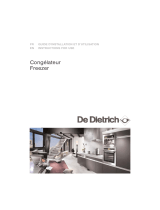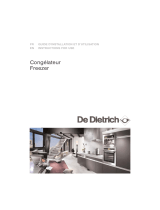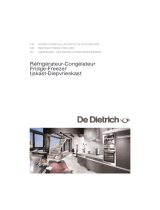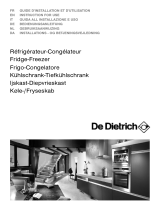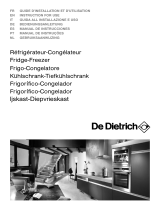Page is loading ...

EN INSTRUCTIONS FOR USE
Freezer

2
1 Safety and the environment
• Safety instructions............................................................................................ 4
• Respecting the environment and saving energy................................................. 5
2 Description of your appliance
• NO FROST: its significance and operation.......................................................... 7
3 How to carry out your initial installation
• Reversing the direction the door opens ............................................................. 8
• Installing your appliance................................................................................... 10
• Electrical connection......................................................................................... 11
4 How to use your freezer
• Starting and adjusting the appliance ................................................................. 12
• Twist Ice (depending on the model).................................................................. 15
• Soft ice cream zone (depending on the model).................................................. 16
• Specific areas of the freezer.............................................................................. 17
• Frozen and deep-frozen food............................................................................ 18
• Preparing food for freezing............................................................................... 18
• Food freezing guide.......................................................................................... 19
• Arranging food in your freezer .......................................................................... 22
• Quick freeze..................................................................................................... 22
• Defrosting food................................................................................................ 23
• Automatic defrosting of your freezer................................................................. 23
5 Ongoing maintenance of your appliance
• Cleaning your appliance.................................................................................... 24
• Changing the light bulb .................................................................................... 24
6 Noise, inconveniences and minor breakdowns
• Normal operating noises................................................................................... 25
• Inconveniences or minor breakdowns............................................................... 25
• Symbols displayed............................................................................................ 27
This guide to installing and using your freezer is applicable to several models. There
may be slight differences between your appliance's details and features and those de-
scribed here.
As you read through the guide, you will come across the following symbols, to warn you of:
Safety precautions that must be observed
Danger of a gas bursting into flame
An electrical danger
Important information and advice
Contents
EN

3
Dear Customer,
You have just acquired a DE DIETRICH freezer and we would like to thank you.
Our research teams have created this new generation of appliances for you. Their
quality, design, features and technological advances make them exceptional products,
and reveal our unique know-how.
Your new DE DIETRICH freezer will blend harmoniously into your kitchen and will
perfectly combine food preservationperformance and ease of use. We wanted to offer
you a product of excellence.
In the DE DIETRICH product range, you will also find a wide choice of hobs, ovens,
microwaves, hoods, dishwashers, cookers, freezers that you can coordinate with your
new DE DIETRICH freezer.
Visit our website www.dedietrich-electromenager.com
where you will find our
latest innovations as well as useful and complementary information.
DE DIETRICH
Setting New Values
As part of our commitment to constantly improving our products, we reserve the right to make
changes to them based on technical advances to their technical and functional features and
appearance.
Warning :
Before installing and using your appliance, please carefully read this Guide to
Installation and Use, which will allow you to quickly familiarise yourself with its
operation.

4
This appliance is intended for domestic use only. It has been designed for preserving and freezing
food.
The following instructions are for your own safety and should be observed without
fail. We can neither be held responsible, nor uphold the guarantee in case of fail-
ure to observe these recommendations, which may lead to material damage or
physical injury.
Your appliance must be installed, fixed if nec-
essary and used in compliance with the in-
structions in this operating and installation
instructions manual in order to avoid any
damage and/or danger due to any lack of sta-
bility or faulty installation.
If the appliance has been delivered to
your home in a horizontal position,
stand it upright and then wait 2 hours
before plugging it in. A small amount of
oil may have flowed into the refrigera-
tion circuit, and you must allow time for
this to flow back towards the motor be-
fore connecting the appliance. Failure
to do so may damage the appliance.
If you appliance is fitted with castors, please
remember that they are only designed to as-
sist in small movements. Do not use them for
longer journeys.
Carry out an initial cleaning operation (see
the section on "Installing your appliance") be-
fore connecting your appliance to the electri-
cal supply. Disconnect your appliance prior to
performing any maintenance operation.
Grasp the plug directly, instead of pulling on
the power cable.
Do not place bottles or jars containing liquids
in the freezer unless they are only two-thirds
full: freezing causes liquids to expand, which
can cause the container to explode.
Do not use any other method than those we
recommend in this manual for speeding up
defrosting.
Do not use electrical equipment inside com-
partments designed for preserving frozen
food unless the manufacturer recommends
otherwise. Do not let children play with the
appliance and keep your pets well away from
it. Worn out appliances must be rendered un-
usable. Unplug and cut the electric cable flush
with the appliance. Render the door catch un-
usable or, better still, remove the door, so as
to ensure that no child or animal risks being
shut inside whilst playing. If a problem arises
that you are unable to resolve using the ad-
vice given (see the "Noise, inconveniences,
minor breakdowns" section), please contact
an official after-sales service or a qualified
professional.
Your appliance's refrigeration circuit
is filled with isobutane refrigerant
(R600a), a natural, non-polluting gas
that is, however, inflammable. Ensure
that none of the components in your
appliance's refrigeration circuit have
been damaged during transport or in-
stallation. If you detect any damage,
keep your appliance away from flames
or any type of source of heat or com-
bustion and ventilate it location.
Safety instructions
EN

5
To reduce your appliance’s electrical consuption:
- Install it in a suitable place see "Installation
of your appliance" section).
- Leave the door open as little as possible. Do
not place food that is still hot in your freezer,
particularly in the case of soups or dishes that
release a lot of steam.
- Periodically check the door seal and make
sure that the door close firmly. If they do not,
lease contact our After-sales service.
In compliance with the latest legislation
concerning environmental protection, your
appliance does not contain any CFCs. Instead
it uses a gas called R600a. The exact type of
refrigerant used in your appliance is also
clearly indicated on the identification plate
inside your appliance's refrigerator section,
low down on the left-hand wall.
R600a is a non-polluting gas that does not
harm the ozone layer and whose contribution
to the greenhouse effect is virtually zero.
ENVIRONMENTAL PROTECTION
This appliance's packaging material is recycla-
ble. Help recycle it and protect the environ-
ment by dropping it off in the municipal
receptacles provided for this purpose.
Your appliance also contains a
great amount of recyclable
material. It is marked with this label
to indicate the used appliances that
should not be mixed with other
waste. This way, the appliance recycling
organised by your manufacturer will be done
under the best possible conditions, in compli-
ance with European Directive 2002/96/EC on
Waste Electrical and Electronic Equipment.
Contact your town hall or your retailer for the
used appliance collection points closest to your
home.
We thank you doing your part to protect the
environment.
Respecting the environment and saving energy
EN

6
Description of your appliance
EN
Twist ice *
Ice trays*
Freezer drawer
Plinth
Drawer Maxi box
Inside door compartiment *
Zone ice cream*
Tiroir inférieur
Flaps
Adjustable feet
Lightning*
Motor
Condenser
* depending on the model
This guide to installing and
using your freezer is applica-
ble to several models. There
may be slight differences be-
tween your appliance's de-
tails and features and those
described here.

7
This appliance has been designed and manufactured to avoid
frost accumulating inside it.
A system automatically melts away any frost and the water
produced flows through a small pipe into the container provided,
where it evaporates away.
You do not need to de-ice the appliance yourself.
NO FROST: its significance and operation
EN

8
The doors normally open to the left (hinges on the right); if you wish to open the door to the right,
you can modify the direction in which it opens by following the instructions below. To ensure cor-
rect installation, please scrupulously follow the directions and the sequence of operations below
:
1. Gently tilt the appliance backwards.
2. Remove the plinth by pulling the lugs A on the
lower part towards you and swivelling the
plinth upwards to disengage it (R1). Remove
cover B from its housing on the left and insert
it in the housing on the right (R2).
3. Remove the bottom hinge pin and release it
from its housing C; retrieve the plastic
distance piece placed between the door and
the hinge on the pin; unscrew the bottom
hinge D and screw the pin into the left-hand
hole in the hinge (R3).
4. Remove the door from the appliance (Drawing
R3).
5. ** Unscrew the metal spacer
Y
(Drawing R3)
located on the bottom right-hand side.
6. ** Turn the spacer
Y
over (Drawing R3) and screw
it onto the bottom left-hand side.
(** Points 5 and 6 apply only to certain models)
7. Remove the spacer and the pin E from the top
hinge and remove it from its housing on the
tight-hand side (Drawing R4).
8. Turn the pin E over 180° and insert it into the
right-hand opening on the top hinge (Drawing
R4).
9. Insert the appliance's door into the top hinge
on the left-hand side (Drawing R4).
10. Insert the bottom hinge D in the door, ensur-
ing that the plastic spacers are correctly insert-
ed over the pins.
11. Screw the bottom hinge D in place.
12. Re-attach the plinth and return the appliance
to a vertical position.
Wait two hours before restarting your
appliance.
Reversing the direction the door opens
EN
Drawing R1
A
A
Drawing R2
B
Dessin R4
Drawing R3
Drawing R4
A
A
C
D
E
E
D
Y

9
Adjusting the hinge
Sometimes the top door and the strip are not perfect-
ly aligned (Drawing R5). In this case, unscrew the
fixing screw slightly from the cover (A) over the top
hinge. Then screw it in again and check that the seal
is perfectly hermetic.
Reversing the direction the door opens
EN
Drawing R5
A

10
Your appliance must be installed in compliance with the instructions given in this
"Operating and installation instructions manual" in order to keep your food under
optimum conditions and with optimal energy consumption.
- The appliance should be installed in a dry,
well-ventilated room.
- Avoid balconies, verandas, and patios: the
excessive heat in summer and the cold in
winter could prevent your appliance from
functioning properly, or may even damage it.
- Do not place your appliance near a heat
source such as an oven or radiator.
- Your appliance has been designed for opti-
mum functioning at a certain ambient temper-
ature; it is designed for a particular "climate
class". This climate class is clearly indicated on
the identification plate situated on the inside of
your appliance, low down on the left wall.
Outside of this temperature range, the perfor-
mance of your appliance may be reduced.
- Maintain a minimum distance between your
appliance and the other units: 3 to 5 cm at the
sides, or 10 cm if your appliance is close to a
wall, and 10 cm above to ensure good circula-
tion of air all around the appliance.
- Position the appliance at a suitable distance
from the wall using the spacers provided in the
accessories packet. The spacers should be
mounted on the back of the appliance (see
Drawing).
Once you have installed your appliance, adjust its feet so that it is tilting backwards slightly:
this helps the door to close correctly.
Before placing any food in your appliance, clean it inside and out with a bicarbon-
ate of soda solution (1 dessertspoon of bicarbonate to 4 litres of water). Do not
use alcohol, scouring powder or detergents, which could damage the surfaces.
See the section on "Cleaning your Appliance".
The optimum functioning of the product is guarantied only if it is installed accord-
ing to the user manual instructions (i.e. free-standing). The factory will not be
hold responsible if the conditions of installing are not fulfilled correctly, as each
modification can compromise the correct functioning.
Installing your appliance
EN
Climate Class Ambient
temperature
N +16°C to +32°C
N-ST +16°C to +38°C
N-T +16°C to +43°C
SN +10°C to +32°C
SN-ST +10°C to +38°C
SN-T +10°C to +43°C
ST +18°C to +38°C
T +18°C to +43°C

11
For your own safety, you must comply with the instructions given below.
The electrical installation must comply with Standard NF C *15-100, in particular concerning
the Earth.
Three-core flex 3x2.5 mm², 230V single-phase connected to:
- A 20A single-phase 230V-50Hz supply
- An ELCB and an individual fuse (10 or 16A depending on the model)
We cannot be held responsible for any incident caused by faulty electrical installation.
Recommendations for the electrical installation of your appliance:
- Do not use extension leads, adaptors, or socket strips.
- Always make sure your circuit is earthed.
- The socket must always remain accessible, yet be out of the reach of children.
If you have any doubts, contact your installer.
If the appliance has been delivered to your home in a horizontal position, stand it
upright and then wait 2 hours before plugging it in. A small amount of oil may have
flowed into the refrigeration circuit, and you must allow time for this to flow back
towards the motor before connecting the appliance. Failure to do so may damage
the appliance.
Carry out an initial cleaning operation (see the section on "Installing your appli-
ance") before connecting your appliance to the electrical supply. Disconnect your
appliance prior to performing any maintenance operation. Grasp the plug directly,
instead of pulling on the power cable.
"In case of damage, the supply cord must be replaced by the technical assistance
service or a person with a similar title, in order to prevent any risk."
Electrical connection
EN
Your appliance is compliant with European Directives CEE/73/23 (low voltage
directive), CEE/89/336 (electromagnetic compatibility) and CEE/96/57 (energy
efficiency) as well as their modifications.

12
Operation of the electronic system
The control panel on the front of your appliance at the top comprises:
-1) "ON/OFF" button: for switching on the appliance.
-2) LCD display screen
-3) ">" button:
The functions are selected by pressing on the ">" button until the desired function starts to flash.
The function selection sequence is always the same:
- 1) Temperature adjustment
- 2) Ice cream: special function for ice cream
- 3) Super freeze (MAX): quick freeze function
- 4) Eco: half-load function
- 5) Excel freeze: quick freezing by type of foodstuffs and weight
- 4) Button
«-», this serves to:
- To reduce the temperature if you are in "temperature setting" mode.
- Deactivate a function.
- 5) Button
«+», this serves to:
- To increase the temperature if you are in "temperature setting" mode.
- Activate a function once selected.
ATTENTION
When the appliance is started, the alarm signal appears. Hold down a button for 3
seconds to cancel it. Then proceed to set the temperature.
The symbol remains lit until the ideal temperature has been reached.
Every time you confirm or deactivate a function a beep sounds.
Starting and adjusting the appliance
EN
1
2
3
4
5

13
Meaning of the symbols and functions that can appear on your screen
Starting and adjusting the appliance
EN
Setting the temperature
• To set the temperature, press the ">" key (3) and then use the "-" (4) and "+" (5)
keys to adjust the temperature. Confirm by pressing the ">" key (3).
• Set approximately by degree from -26°C to -16°C.
• You can see the freezer's actual temperature by holding down the "+" key for more
than 3 seconds
• If the actual temperature is lower than -30°C, the «LO» symbol appears instead of
the temperature. If it is over -5°C, the « HI» symbol appears.
Ice cream function
• This function enables you to keep ice cream (out of the carton) at an optimum
temperature so that it is ready to be eaten immediately.
• When the function is activated on the screen, the symbol "IC" appears in place of
the temperature.
• To activate the function, press the ">" (3) key and then press the "+" button (5)
when the Ice Cream symbol flashes to confirm your choice. To cancel the function,
repeat the same operation but press the "-" key (4).
Max function
• This function enables you to deep freeze a large varied amount of fresh food.
• When the function is activated, the MAX light remains lit and the symbol «
A» ap-
pears instead of the freezer's temperature.
• We recommend that you activate the function 24 hours before introducing the food.
• The function stops automatically after 52 hours or can be stopped manually by
deactivating the function.
• To activate the function, press the ">" (3) key and then press the "+" button (5)
when the Max symbol flashes to confirm your choice. To cancel the function, repeat
the same operation but press the "-" key (4).
Freeze Excel function
• This system helps you to freeze food efficiently. It enables you to adapt the freezing
time to suit the weight and the type of food you wish to freeze.
• In this mode, the screen invites you to select one of the following 4 types of food:
- Bread/Pizza/Pastries
- Meat
- Vegetables
- Fish
• Proceed as follows to activate this function:
• Press the ">" button until the four symbols and the letters "FE" flash.
• Press the "+" button to select the type of food (the bread symbol and FE both
flash). Continue and press the "+" button to select the other foodstuffs
(the selection sequence is bread, meat, vegetables, fish).
• To confirm the foodstuff selected, press the "Mode" button (the symbol for the
selected foodstuff is permanently displayed and the weight flashes)
• To select the weight (maximum 9kg), press the "-" or "+" buttons. Press the ">"
button to confirm your choice (the weight selected is displayed constantly for a
few seconds and the "FE" symbol appears).
• After approximately 30 seconds, the temperature is shown on the screen.
• If you wish to freeze more than 9kg of different types of food, activate the Super
freeze (MAX) function.

14
Meaning of the symbols and functions that can appear on your screen
ATTENTION
Your internal temperature is strictly dependent on the ambient temperature, how frequently
the appliance's door are opened and the amount and the temperature of the food you have
placed in the freezer. You must therefore regularly check the temperature indicator on your
freezer and adjust the temperature setting if necessary.
The temperatures that appear on the screen correspond to the requested temperatures and
not the actual temperatures.
Even when the screen is off, there is still mains power to your appliance.
Starting and adjusting the appliance
EN
Eco function
• When the function is activated, the symbol "EC" is displayed on the screen in place
of the temperature. This function enables you to save energy (15%) when you
appliance is only half loaded. When this function is engaged, we recommend that
you store all your frozen food on the two shelves above the second drawer.
• To activate the function, press the ">" (3) key and then press the "+" button (5)
when the "EC" symbol flashes to confirm your choice. To cancel the function, repeat
the same operation but press the "-" key (4).
ALARMS
Door open alarm
• The alarm is activated when the door remains open for more than 60 seconds. The
indicator light illuminates and the audible alarm is triggered. Press a button to stop
the alarm.
Freezer Temperature Rise alarm
After a power failure, your appliance indicates whether you can continue to keep the
frozen food or not.
• When the alarm is operating the following symbols may be displayed:
- If the "Store" symbol illuminates , your frozen items are intact and you
can continue to store them without a problem.
- If the "Cook and the alarm symbols" light up , you must cook your food
items.
- If the "Bin and the alarm symbols" light up , you must dispose of the
items in your freezer
• Press a button to cancel the indicator lights.
ALARMS
• If this signal appears instead of the freezer temperature, it means that the tempe-
rature sensors are probably defective.
• A safety procedure starts automatically to ensure that the appliance can operate but
the Technical Assistance Department must be called.
• If this letter appears in place of the temperature, it means that there is a problem
with the electricity supply. An automatic testing procedure is initiated for 5 minutes
and then normal operation resumes.
• If this message appears in place of the freezer's temperature, this means that the
defrosting system's resistance is probably defective. Call the Technical Assis-
tance Department.

15
Your freezer can be fitted with a "Twist Ice"
function.
This produces 24 ice cubes at the same
time. Remove the ice cubes drawer A by
pulling on the four sides.
- Fill the ice cube trays ¾ full with water
(Drawing R1). Filling them partially full
enables you to extract the ices cubes more
easily and avoids water spilling when you
are manipulating the drawer.
- Reinsert the drawer A (Drawing R2)
containing the ice cube trays filled with
water back into its housing and push it in
up to the stop.
- Wait at least 2 hours and then turn the
handles B (Drawing R3) clockwise up to the
point where you are pushing slightly
against the position of the limit switch on
rotation. This movement enables you to
bend the ice cube trays and make the ice
cubes fall into the ice cube drawer C
(Drawing R4) located just beneath.
- Let the handles return to rest position and
repeat the operation several times until all
the ice cubes have fallen into the drawer C
(Drawing R4).
- You can now pull out the ice cube drawer
by pulling the handle. The ice cubes are
ready for use. Return the ice cube draw C
to its housing, pushing it in fully up to the
stop.
Twist Ice (depending on the model)
EN
drawing R2
drawing R3
drawing R4
drawing R1
B
A
A
C

16
The Ice Cream function must be activated
from the control panel (see the section on
"Switching on and adjusting the appliance").
- When the function is activated, you must
wait 8 hours before the ideal temperature for
eating ice cream is reached.
- During the main period for eating ice cream,
you are recommended to use this function on
a continuous basis.
The ice cream box is located inside the drawer
on the second level of your appliance
(see drawing).
- To store your ices, pull the drawer out three-
quarters of the way and lift the lid. Arrange
your ices inside the box (without the card-
board packaging).
- Close the lid and slide the drawer back into
the freezer.
- When you are not using this function, you
can remove the box and use the drawer as
normal storage space.
Warning:
The cardboard carton around your ice cream
must be thrown away; otherwise, this can
prevent your ice cream box from working
properly.
Soft ice cream zone (depending on the model)
EN
Drawing R1

17
Your freezer may be fitted with specific areas
designed for storing certain foodstuffs:
Fragile fruit tray*
A removable tray (Drawing R1), which can be
placed on any standard width drawer. This tray
enables you to store small items of food and
fragile fruit such as, red currents and bilberries,
etc.
Inside door compartment*
This areas is located on the inside face of the
freezer door (Drawing R2). It can be used for
storing frozen herbs and condiments, boxes of
frozen pizza, vacuum packed pizzas and also be
used to store ice pops outside their carton.
Eutectic containers*
This appliance is supplied with eutectic
containers (Drawing R3) designed to increase
autonomous operation during power failures
and reduce energy consumption. The contain-
ers should preferably be placed in the top part
of the appliance.
*= Depending on the model
Specific areas of the freezer
EN
Drawing R1
Drawing R2
Drawing R3

18
Your domestic appliance enables you to freeze food: it lowers its core temperature rapidly and
you can therefore keep it longer.
Deep-freezing is an industrial process that is quicker and more intense that domestic freezing.
The products you purchase from the shops are deep-frozen.
Freezing does not sterilise. It is
therefore important to observe
some simple hygiene rules when
preparing your food for freezing:
wash your hands before you touch
the food and clean the kitchen tools
you have just used before using
them again.
Only freeze fresh, good quality food. Refer to
the table "Food Freezing Guide" to know which
products you can freeze and how long you can
keep them.
Blanch fruit and vegetables before freezing
them to preserve their colour, smell, taste and
vitamins: plunge them in boiling water for a
few moments.
Divide the food you wish to freeze into small
individual portions corresponding to one meal
each. Small portions freeze quicker at their
core.
Pack the food hermetically so that they do not
lose their flavour or dry up. Use plastic bags,
polyethylene film, aluminium foil or special
freezer containers for this.
If you are using plastic bags, compress them
to eliminate the air before sealing them
hermetically.
Do not place bottles or jars contain-
ing liquids in the freezer unless
they are only two-thirds full: freez-
ing causes liquids to expand, which
can cause the container to explode.
Note on each package:
- The freezing date
- The consume-by date
- The type of food contained
- The number of portions contained
If you are purchasing deep-frozen food, pick it
up last when you are shopping.
Check that:
- The packaging isn't damaged
- They are not covered in a layer of frost (which
means that they have partially defrosted).
Pack them in an isothermic bag or in newspa-
per. Transport them quickly and store them
immediately.
Frozen and deep-frozen food
EN
Preparing food for freezing

19
Fresh meat
We recommend that you defrost meat completely before cooking it so as to avoid the exterior cooking
quicker than the interior, except in the case of small breadcrumbed items, which can be sautéed directly
over a low to medium heat, and boiled meats.
Farmyard animals
Prepare them plucked/skinned, gutted, cut into pieces if necessary, washed and rinsed.
Game
Prepare it plucked/skinned, gutted, cut into pieces if necessary, washed and rinsed.
Fish
Food freezing guide
EN
Product Valid for
Lamb,small pieces 8 months
Roast pork 5 months
Pork ribs 4 months
Boiled beef,roast beef 10 months
Beef steak,entrecotes,in sauce,roast veal 8 months
Veal steaks,cutlets 10 months
Minces meat 4 months
Giblets,offal 3 months
Sausages 2 months
Product Valid for
Duck 4 months
Rabbit 6 months
Boiling fowl 7 months
Goose 4 months
Chicken 10 months
Turkey 6 months
Giblets,offal 3 months
Product Valid for
Wild duck,woodcock,pheasant 8 months
Hare 6 months
Partridge,quail 8 months
Product Valid for Preparation
Carp
2 months Descale,gut and remove the head. Wash,rinse and freeze
Pike
Turbot
Salmon
Mackerel
Tench
Trout
Sea bream
3 months
Descale,gut,remove the head and place in cold salty water for 30 seconds,
rinse and freeze. Sole

20
Cooked food
The length of time you can store cooked dishes reduces if you use bacon or smoked ham to season dishes.
Put them directly on the hob or in the oven without defrosting them.
Vegetables
We recommend that you blanch the vegetables with steam so that they do not lose their vitamins and
mineral salts in the cooking water. You therefore do not need to wait until they are dry before freezing
them, just until they cool down.
In general, vegetables are better if they are cooked directly, without being frozen. Reduce the cooking
time, taking into account the blanching time before freezing...
Food freezing guide
EN
Product Valid for Preparatory
cooking
Sauce with meat juices
3 months
half-cooked
Tomato sauce just-cooked
Minestrone with vegetables 2 months no pasta
Lasagne 4 months half-cooked
Roasts 2 months just-cooked
Calf’s leg 1 months
half-cooked
Meat in sauce 3 months
Stewed game 2 months just-cooked
Boiled fish,grilled/baked fish
2 months half-cooked
Sweet peppers,aubergines,courgettes stuffed with meat
Sautéed mushrooms with garlic and parsley,ratatouille
Steamed spinach
Pizza 6 months just-cooked
Product Valid for Preparation Blanching time
Asparagus 12months Wash and remove the strings 2 minutes
Cabbage,cauliflower 6 months Clean an cut into pieces 2 minutes (1)
Artichokes
12months
Remove the external leaves 6 minutes (1)
Beans Shell 3 minutes
Green beans Wash and remove the ends 4 minutes
Mushrooms Clean 2 minutes (1)
Aubergines Wash and slice 4 minutes (2)
Sweet peppers (3) Wash slice and remove the seeds
do not blanchPeas,Tomatoes (3)
Shell and freeze immediately,laying them in a
single layer and then wrapping them
Parsley,basil 8 months
Wash
Spinach
12months
2 minutes
Mixed vegetables for
minestrone (céleri, carrots,
chard,leeks, etc.)
Wash, cut into pieces and divide up into
portions. Do not add potatoes terre: they go
black.
do not blanch
(1) Add a little vinegar or lemon juice to the cooking water (slightly acid water).
(2) Pickle in brine before cooking.
(3) During defrosting,these vegetables reduce to a mush because they contain enormous amounts of water.
We recommend that you defrost them only if you wish to eat them coked.
/
